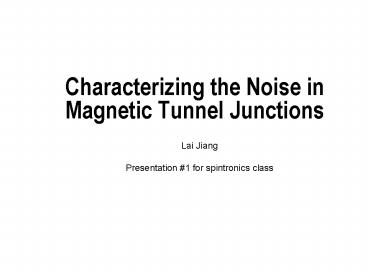Characterizing the Noise in Magnetic Tunnel Junctions - PowerPoint PPT Presentation
1 / 12
Title:
Characterizing the Noise in Magnetic Tunnel Junctions
Description:
'White noise' has origin in thermal and shot noise mechanisms. 2eIRdcoth(eV/2kT) ... eV kT Shot noise: 2eIRd2. Sv 2eIRdcoth(eV/2kT) I 2Rd2/Af ... – PowerPoint PPT presentation
Number of Views:58
Avg rating:3.0/5.0
Title: Characterizing the Noise in Magnetic Tunnel Junctions
1
Characterizing the Noise in Magnetic Tunnel
Junctions
Lai Jiang Presentation 1 for spintronics class
2
Introduction
- Why is noise interesting
- - Technological Aspects
- limits sensitivity of devices (field
sensor) - - A tool for studying material
- provides valuable information about
- .defects in the tunnel barrier
- .magnetic dynamics
3
Introduction
- structure of a Magnetic Tunnel Junction(MTJ)
4
Introduction
MagnetoResistance (MR)
5
Introduction
typical magnetoresistance loop of MTJs
L. Jiang, E. R. Nowak et. al., Physical Review B
69, 054407 (2004).
6
Schematic of Experiment
7
Voltage fluctuations
- A crossover from I/f noise to f independent
noise - 1/f noise reflects the Charge trapping and
detrapping process in the AlO barrier. - ?I 2Rd2/Af
- White noise has origin in thermal and shot
noise mechanisms - 2eIRdcoth(eV/2kT)
- eVltltkT thermal noise 4kTRd
- eVgtgtkT Shot noise 2eIRd2
Sv?2eIRdcoth(eV/2kT)?I 2Rd2/Af
L. Jiang, E. R. Nowak et. al., Physical Review B
69, 054407 (2004).
8
Voltage fluctuations
predicted shot noise 2eIRd2
the frequency independent portion of Sv scales
in agreement with the
L. Jiang, E. R. Nowak et. al., Physical Review B
69, 054407 (2004).
9
Thermal magnetization fluctuations
- The noise and dR/dH are observed to have similar
field dependence. In qualitative agreement with
the Fluctuation Dissipation (FD) relation - ?R/?H2mm0 /kTDR (R2/A) ln(fmax/fmin)a
- H.T.Hardner et al. Phys. Rev. B48, 16156(1993)
L. Jiang, E. R. Nowak et. al., Physical Review B
69, 054407 (2004).
10
Telegraph Noise
- A dramatic spike in noise is seen as the free
layer undergoes reversal
- Random telegraph noise is observed in the time
domain. - The signals duty cycle is extremely sensitive to
the applied field.
L. Jiang, E. R. Nowak et. al., Physical Review B
69, 054407 (2004).
11
Telegraph Noise
- The probability distributions for the time spent
in the up and down states for the telegraph
noise - D(t)? exp(-t/t)
- The transition rates are assumed to follow
- 1/ti?j(H)1/t0 exp(-E?Dm?H/kT)
- Dm can be estimated from the ratio of lifetimes
- ti?j(H) /tj?i(H) exp(2Dm?H/kT)
L. Jiang, E. R. Nowak et. al.,Physical Review B
69, 054407 (2004).
12
Conclusion
- Noise Mechanisms
- 1. Johnson-Nyquist(Thermal)
- 2. Shot
- set ultimate sensitivity
- 3. Magnetic
- field fluctuation
- 4. Telegraph
- free layer reversal
- 5. Resistance - charge trapping processes
- 1/f-ish































